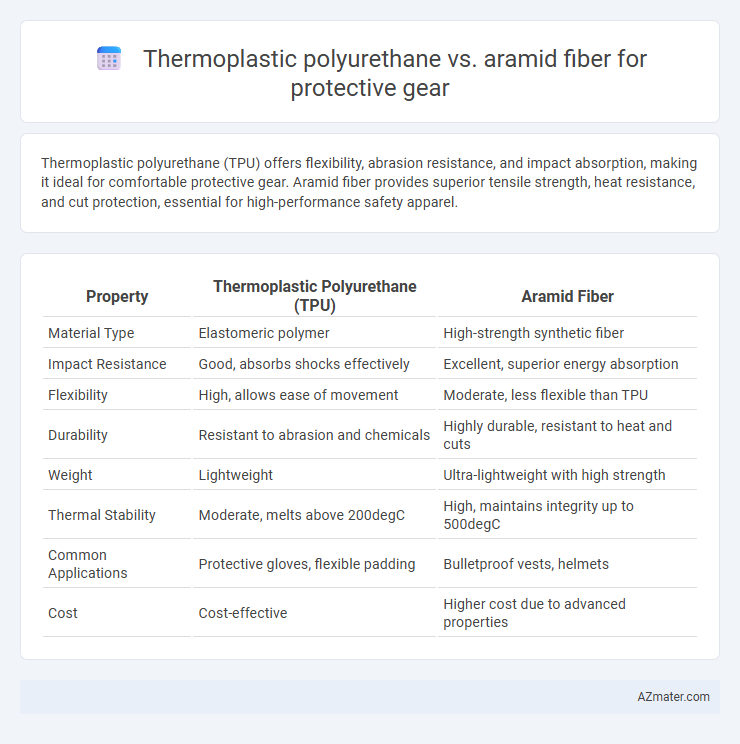Thermoplastic polyurethane (TPU) offers flexibility, abrasion resistance, and impact absorption, making it ideal for comfortable protective gear. Aramid fiber provides superior tensile strength, heat resistance, and cut protection, essential for high-performance safety apparel.
Table of Comparison
| Property | Thermoplastic Polyurethane (TPU) | Aramid Fiber |
|---|---|---|
| Material Type | Elastomeric polymer | High-strength synthetic fiber |
| Impact Resistance | Good, absorbs shocks effectively | Excellent, superior energy absorption |
| Flexibility | High, allows ease of movement | Moderate, less flexible than TPU |
| Durability | Resistant to abrasion and chemicals | Highly durable, resistant to heat and cuts |
| Weight | Lightweight | Ultra-lightweight with high strength |
| Thermal Stability | Moderate, melts above 200degC | High, maintains integrity up to 500degC |
| Common Applications | Protective gloves, flexible padding | Bulletproof vests, helmets |
| Cost | Cost-effective | Higher cost due to advanced properties |
Introduction to Protective Gear Materials
Thermoplastic polyurethane (TPU) offers high flexibility, abrasion resistance, and impact absorption, making it ideal for lightweight protective gear components. Aramid fiber, known for its exceptional tensile strength and heat resistance, provides superior cut and puncture protection in helmets and body armor. Combining TPU's elasticity with aramid fiber's durability enhances overall safety performance in advanced protective equipment.
Overview of Thermoplastic Polyurethane (TPU)
Thermoplastic Polyurethane (TPU) is a versatile polymer known for its excellent elasticity, abrasion resistance, and impact absorption properties, making it a popular choice in protective gear manufacturing. TPU offers superior flexibility and durability compared to traditional materials, providing enhanced comfort and sustained protection under dynamic conditions. Its resistance to oils, chemicals, and varying temperatures ensures long-lasting performance in demanding environments.
Key Properties of Aramid Fiber
Aramid fiber offers exceptional tensile strength, high thermal resistance up to 500degC, and outstanding cut and abrasion resistance, making it ideal for protective gear in high-risk environments. Unlike thermoplastic polyurethane, aramid fibers maintain structural integrity under extreme heat and mechanical stress, providing superior durability and impact protection. Its lightweight nature and chemical stability enhance comfort and longevity in advanced safety equipment.
Impact Resistance: TPU vs Aramid Fiber
Thermoplastic polyurethane (TPU) offers excellent flexibility and abrasion resistance, providing effective impact absorption by dispersing force over a larger area in protective gear. Aramid fiber, such as Kevlar, excels in high tensile strength and energy dissipation, delivering superior resistance to penetration and blunt force trauma. Comparing TPU and aramid fiber, TPU is ideal for lightweight, flexible applications, while aramid fiber ensures maximum impact resistance and durability in high-risk environments.
Flexibility and Comfort Comparison
Thermoplastic polyurethane (TPU) offers superior flexibility and comfort in protective gear due to its elastic properties and lightweight nature, allowing for greater freedom of movement and prolonged wearability. Aramid fiber, known for its exceptional strength and heat resistance, provides robust protection but tends to be stiffer and less breathable, which can reduce overall comfort during extended use. When prioritizing flexibility and comfort in protective equipment, TPU-based materials typically outperform aramid fiber composites.
Durability and Wear Resistance
Thermoplastic polyurethane (TPU) exhibits exceptional abrasion resistance and flexibility, making it ideal for protective gear subjected to frequent impact and friction. Aramid fiber, renowned for its high tensile strength and heat resistance, offers superior durability against cuts and thermal hazards in extreme environments. Combining TPU's wear resistance with aramid fiber's robustness enhances overall protective gear performance in durability-critical applications.
Weight and Mobility Factors
Thermoplastic polyurethane (TPU) offers superior flexibility and lightweight properties, enhancing mobility in protective gear for sports and industrial applications. In contrast, aramid fiber, such as Kevlar, provides exceptional strength and impact resistance but is significantly heavier, which can limit agility and increase fatigue during prolonged use. Balancing weight and protection, TPU is favored for gear requiring high movement, while aramid fiber suits scenarios demanding maximum durability and impact defense.
Chemical and Environmental Resistance
Thermoplastic polyurethane (TPU) offers excellent chemical resistance against oils, solvents, and abrasion, making it highly durable in harsh environmental conditions. Aramid fiber demonstrates superior heat resistance and maintains strength when exposed to extreme temperatures but is more susceptible to degradation from prolonged UV exposure and certain chemicals like strong acids. For protective gear requiring robust chemical and environmental resistance, TPU provides versatile protection, while aramid fiber excels in thermal stability and mechanical performance.
Cost and Manufacturing Considerations
Thermoplastic polyurethane (TPU) offers cost-effective production with lower raw material expenses and easier processing methods such as injection molding or extrusion, making it suitable for mass manufacturing of protective gear. In contrast, aramid fiber, known for its high strength and heat resistance, involves higher material costs and complex fabrication processes like weaving and lamination, increasing overall production expenses. Manufacturers must weigh TPU's economical scalability against aramid fiber's superior performance and associated costs when selecting materials for protective equipment.
Choosing the Best Material for Protective Gear
Thermoplastic polyurethane (TPU) offers excellent flexibility, abrasion resistance, and impact absorption, making it ideal for comfortable and durable protective gear. Aramid fiber, known for its exceptional tensile strength and heat resistance, provides superior cut and ballistic protection, often used in high-performance body armor. Selecting the best material depends on the specific protective requirements, with TPU favored for lightweight and flexible applications, while aramid fiber excels in heavy-duty, high-risk environments.

Infographic: Thermoplastic polyurethane vs Aramid fiber for Protective gear
 azmater.com
azmater.com